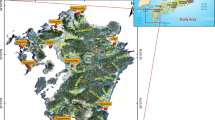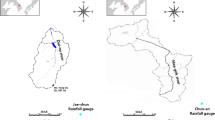Abstract
Flash floods are severe disasters that devastate the environment, society, and economy in arid regions. Due to the scarcity of observed data from prior incidents, flash flood hazard mapping (FFHM) using Remote Sensing (RS), Geographic Information System (GIS) and hydrological modeling elements has recently become a feasible method for the fundamental management of basins. El-Shamy approach is a straightforward, widely used method for FFHM. This is the first study to investigate the effect of a stream threshold (St) change on the results of El-Shamy approach. Furthermore, runoff peak discharge- and runoff volume-based flash flood hazard degrees (Rp-HD and Rv-HD) were explored. For El-Shamy approach, St = 0.1 km2 was found to be the best among the considered values for well-distributed estimates of flash flooding potential. A Receiver Operating Characteristic (ROC) curve using historical data was employed to evaluate the considered methods and revealed that El-Shamy suffered from a precision lack, with an Area Under Curve (AUC) equal to 0.36 and 0.45 for low and high hazard basins, respectively, indicating a slight reverse prediction tendency. While Rp-HD and Rv-HD attained a similarly significant and reliable accuracy, with an AUC equal to 1.0 and around 0.865 for low and high hazard basins, respectively. Moreover, Rp-HD was recommended due to its cautious prediction. Accordingly, the FFHM for the study area was presented and associated guiding sustainable management measures were suggested to help decision-makers partially achieve Sustainable Development Goals (SDGs).
Access this chapter
Tax calculation will be finalised at checkout
Purchases are for personal use only
Similar content being viewed by others
References
Eliwa, H.A., Murata, M., Ozawa, H.: Post Aswan High Dam flash floods in Egypt: Causes, consequences and mitigation strategies. Bull. Center Collaborat. Community Naruto Univ. Educ. 29(2), 173–186 (2015)
Helmi, A.M., Zohny, O.: Flash flood risk assessment in Egypt. In: Negm, A.M. (ed.) Flash floods in Egypt. ASTI, pp. 253–312. Springer, Cham (2020). https://doi.org/10.1007/978-3-030-29635-3_13
Youssef, A.M., Pradhan, B., Hassan, A.M.: Flash flood risk estimation along the St Katherine road, southern Sinai, Egypt using GIS based morphometry and satellite imagery. Environ. Earth Sci. 62(3), 611–623 (2011)
Abdelkader, M.M., Al-Amoud, A.I., El Alfy, M., El-Feky, A., Saber, M.: Assessment of flash flood hazard based on morphometric aspects and rainfall-runoff modeling in Wadi Nisah, central Saudi Arabia. Remote Sens. Appl. Soc. Environ. 23(100562) (2021)
Mansour, M.M., Ibrahim, M.G., Fujii, M., Nasr, M.: Recent applications of flash flood hazard assessment techniques: case studies from Egypt and Saudi Arabia. Adv. Eng. Forum 47, 101–110 (2022). https://doi.org/10.4028/p-03z404
Nasir, M.J., Iqbal, J., Ahmad, W.: Flash flood risk modeling of swat river sub-watershed: a comparative analysis of morphometric ranking approach and El-Shamy approach. Arab. J. Geosci. 13(20), 1–19 (2020). https://doi.org/10.1007/s12517-020-06064-5
Ben Khélifa, W., Mosbahi, M.: Modeling of rainfall-runoff process using HEC-HMS model for an urban ungauged watershed in Tunisia. Modeling Earth Syst. Environ. 1 (2021). https://doi.org/10.1007/s40808-021-01177-6
Lin, K., et al.: Assessment of flash flood risk based on improved analytic hierarchy process method and integrated maximum likelihood clustering algorithm. Journal of Hydrology, 584(124696), (2020)
Dadamouny, M.A., Schnittler, M.: Trends of climate with rapid change in Sinai Egypt. J. Water Clim. Change 7(2), 393–414 (2016)
Mansour, M.M., Nasr, M., Fujii, M., Yoshimura, C., Ibrahim, M.G.: Quantification of flash flood runoff volume using morphometric parameters towards sustainability. In: Ujikawa, K., Ishiwatari, M., Hullebusch, E.V. (eds.) Environment and Sustainable Development. ACESD 2022. Environmental Science and Engineering. Springer, Singapore, (Forthcoming 2023)
Mansour, M.M., Ibrahim, M.G., Fujii, M., Nasr, M.: Sustainable development goals (SDGs) associated with flash flood hazard mapping and management measures through morphometric evaluation. Geocarto International (2022). https://doi.org/10.1080/10106049.2022.2046868
EXCIMAP, European exchange circle on flood mapping: Handbook on good practices for flood mapping in Europe. European Environment Agency, Copenhagen, Denmark (2007)
El-Shamy, I.: New approach for hydrological assessment of hydrographic basins of recent recharge and flooding possibilities. In: 10th Symposium Quaternary and Development proceedings on proceedings, p. 15, Mansoura, Egypt, April 1992
Mansour, M.M., Nasr, M., Fujii, M., Yoshimura, C., Ibrahim, M.G.: Identification of a practical method and a set of morphometric parameters for flash flood potential prioritization. In: 14th International Conference on Hydroscience & Engineering (ICHE2022) on proceedings, pp. 603–615. Izmir, Turkey (2022)
Schumm, S.A.: Evolution of drainage systems and slopes in badlands at Perth Amboy, New Jersey. Bull. Geol. Soc. Am. 67(5), 597–646 (1956)
Horton, R.E.: Erosional development of streams and their drainage basins; hydrophysical approach to quantitative morphology. Geol. Soc. Am. Bull. 56(3), 275–370 (1945)
Strahler, A.N.: Revision of Hortons’ quantitative factors in erosional terrain. Trans. Am. Geophys. Union 34, 345–365 (1953)
Scharffenberg, W.A.: Hydrologic modeling system HEC-HMS: User's manual version 4.2. U.S. Dept. of Agriculture, Hydrologic Engineering Center, Davis, CA, USA (2016)
Mockus, V.: Watershed lag. U.S. Dept. of Agriculture, Soil Conservation Service, Washington, DC (1961)
Song, X., Kong, F., Zhu, Z.: Application of Muskingum routing method with variable parameters in ungauged basin. Water Sci. Eng. 4(1), 1–12 (2011)
Abdel-Lattif, A., Sherief, Y.: Morphometric analysis and flash floods of Wadi Sudr and Wadi Wardan, Gulf of Suez, Egypt: using digital elevation model. Arabian J. Geosci. 5, 181–195 (2012)
Reddy, G.P.O., Kumar, N., Sahu, N., Singh, S.K.: Evaluation of automatic drainage extraction thresholds using ASTER GDEM and Cartosat-1 DEM: a case study from basaltic terrain of Central India. Egyptian J. Remote Sens. Space Sci. 21(1), 95–104 (2018)
Zidan, A., Abdalla, M., Khalaf, S., Saqr, A.M.: Kinetic energy and momentum coefficients for Egyptian irrigation canals. Mansoura Eng. J. 41(1), 1–16 (2016). https://doi.org/10.21608/bfemu.2020.99368
Allam, A., Helal, E., Mansour, M.: Retarding contaminant migration through porous media using inclined barrier walls. J. Hydrol. Hydromechan. 67(4), 339–348 (2019)
Mansour, M.M., Ellayn, A.F., Helal, E., Rashwan, I.M.H., Sobieh, M.F.: Delaying solute transport through the soil using unequal double sheet piles with a surface floor. Ain Shams Eng. J. 9(4), 3399–3409 (2018). https://doi.org/10.1016/j.asej.2018.10.003
Saqr, A.M., Ibrahim, M.G., Fujii, M., Nasr, M.: Sustainable Development Goals (SDGs) associated with groundwater over-exploitation vulnerability: geographic information system-based multi-criteria decision analysis. Nat. Resour. Res. 30(6), 4255–4276 (2021). https://doi.org/10.1007/s11053-021-09945-y
Saqr, A.M., Ibrahim, M.G., Fujii, M., Nasr, M.: Simulation-optimization modeling techniques for groundwater management and sustainability: a critical review. Adv. Eng. Forum 47, 89–100 (2022). https://doi.org/10.4028/p-50l1j1
Saqr, A.M., Nasr, M., Fujii, M., Yoshimura, C., Ibrahim, M.G.: Monitoring of agricultural expansion using hybrid classification method in southwestern fringes of Wadi El-Natrun, Egypt: an appraisal for sustainable development. In: Ujikawa, K., Ishiwatari, M., Hullebusch, E.V. (eds) Environment and Sustainable Development. ACESD 2022. Environmental Science and Engineering. Springer, Singapore, (Forthcoming 2023)
Acknowledgements
The first author is very grateful to the Egyptian Ministry of Higher Education (MoHE) for providing financial support in the form of a Ph.D. scholarship. Also, thanks to the Japan International Cooperation Agency (JICA) for providing all the facilities, and equipment to accomplish this research.
Author information
Authors and Affiliations
Corresponding author
Editor information
Editors and Affiliations
Rights and permissions
Copyright information
© 2023 The Author(s), under exclusive license to Springer Nature Singapore Pte Ltd.
About this paper
Cite this paper
Mansour, M.M., Nasr, M., Fujii, M., Yoshimura, C., Ibrahim, M.G. (2023). Evaluation of a Reliable Method for Flash Flood Hazard Mapping in Arid Regions: A Case Study of the Gulf of Suez, Egypt. In: Chen, X. (eds) Proceedings of the 2022 12th International Conference on Environment Science and Engineering (ICESE 2022). ICESE 2022. Environmental Science and Engineering. Springer, Singapore. https://doi.org/10.1007/978-981-99-1381-7_10
Download citation
DOI: https://doi.org/10.1007/978-981-99-1381-7_10
Published:
Publisher Name: Springer, Singapore
Print ISBN: 978-981-99-1380-0
Online ISBN: 978-981-99-1381-7
eBook Packages: Earth and Environmental ScienceEarth and Environmental Science (R0)




